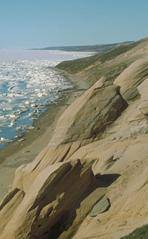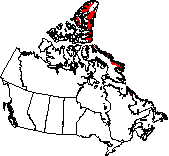|
Location
| Climate | Geology and geography
| Flora and fauna | Humans | Images
Location
The Arctic Cordillera
runs along the northeastern fringe of Nunavut and Labrador, notably
on Ellesmere and Baffin Islands.
Climate
This ecozone is one of the most inhospitable in Canada. Summer temperatures
range from -2 degrees in the mountains of Ellesmere Island to 6 degrees
in northern Labrador, but winter brings temperatures as low as -35ºC
in the north. Precipitation is commonly snow, and the north has an average
of only 200mm of precipitation a year, although in Labrador it can reach
as much as 600mm annually. Although winter is long and dark, the short
growing season is aided by the extremely long days come summer.
Geology
and Geography
 Containing
soaring mountain peaks and desolate valleys, the northern extent of
this ecozone contains mountains that exceed two kilometres in height,
some of the highest in the country. This is the only major mountain
chain in Eastern Canada. Precambrian rock is the major component of
the bedrock. The drier northern section is largely covered with ice
caps while glaciers are common at the more humid southern end. Containing
soaring mountain peaks and desolate valleys, the northern extent of
this ecozone contains mountains that exceed two kilometres in height,
some of the highest in the country. This is the only major mountain
chain in Eastern Canada. Precambrian rock is the major component of
the bedrock. The drier northern section is largely covered with ice
caps while glaciers are common at the more humid southern end.
Flora
and Fauna
Plants
Not much can grow in the harsh conditions, where killing frosts can
come at any time during the year and even soil is rare. Three-quarters
of the land here is bare rock; and even lichen have a hard time of it.
Trees here are barely recognizable stunted versions of themselves. Plants
that do grow here are usually tiny species that often grow in thick
insulating mats to protect themselves from the cold or are covered in
thick hairs that help to insulate and to protect them from the bitter
wind.
Some of the plant species
found are arctic black spruce, arctic willow, cottongrass, kobresia,
moss species, wood rush, wire rush, purple saxifrage, Dryas species,
sedges, Diapensia, arctic poppy, mountain avens, mountain sorrel,
river beauty, moss campion, bilberry, and arctic white heather.
Animals
The conditions here are far too harsh for reptiles and amphibians
to survive, and insects are also rare here.
Mammals
Muskoxen
and barren-ground caribou are the only large herbivores in this ecosystem,
while polar
bears and the
arctic wolf are the only large carnivores to be found here. Smaller
herbivores include the arctic
hare and the collared
lemming. Arctic
foxes and ermines
are some of the smaller carnivores found here. Marine mammals include
narwhals,
beluga whales,
walrus,
and ringed
and bearded
seals.
Birds
The furry-legged rock
ptarmigan is a common bird in this desolate place. Characteristic
birds of prey include the gyrfalcon
and snowy owl.
Some of the more common shore- and seabirds are the thick-billed
murre, black-legged
kittiwake, ruddy
turnstone, red
knot, black
guillemot, common
ringed plover, little ringed plover and northern
fulmar. Songbirds found in the Arctic Cordillera include the hoary
redpoll, common
redpoll, snow
bunting, and lapland
longspur. The snow
goose, common
and king eider,
and red-throated
loon are some species of waterfowl that live here.
Humans
Only about a thousand people live permanently in this region and most
of the population is Inuit. Most people live through subsistence activities,
such as hunting, trapping and fishing, although gas and oil exploration
also provide a living for some.
Images
Bylot Island
Pond
Inlet, Baffin Island
Ice
tongue, Ellesmere Island
Mokka
Fjord, Axel Heiberg Island


|
|




 Containing
soaring mountain peaks and desolate valleys, the northern extent of
this ecozone contains mountains that exceed two kilometres in height,
some of the highest in the country. This is the only major mountain
chain in Eastern Canada. Precambrian rock is the major component of
the bedrock. The drier northern section is largely covered with ice
caps while glaciers are common at the more humid southern end.
Containing
soaring mountain peaks and desolate valleys, the northern extent of
this ecozone contains mountains that exceed two kilometres in height,
some of the highest in the country. This is the only major mountain
chain in Eastern Canada. Precambrian rock is the major component of
the bedrock. The drier northern section is largely covered with ice
caps while glaciers are common at the more humid southern end.